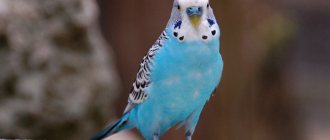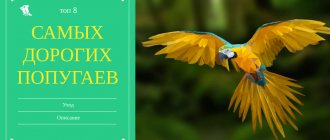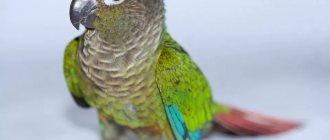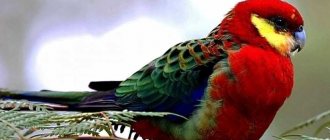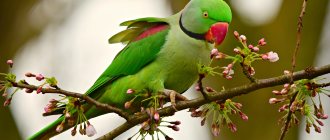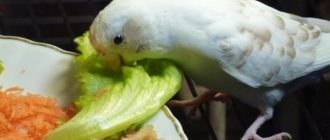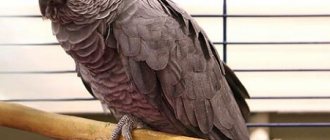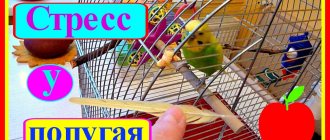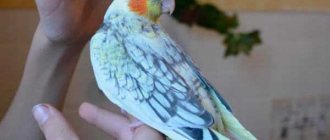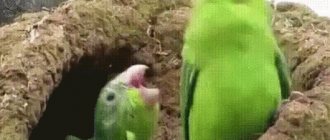Beautiful, intelligent and friendly, parrots are one of the most popular pets. Many people value them not only for their bright colors, but also for their high intellectual abilities. Different types of parrots have certain abilities. Some are more predisposed to copying sounds, while others are able to clearly reproduce human speech.
Among all the breeds of parrots, one species can be distinguished, which differs significantly from its feathered counterparts. This type of domestic parrot is capable of not only copying human speech and imitating intonation, but is also capable of conducting a meaningful dialogue and distinguishing colors and objects. Who claims to be the smartest parrot in the world and which species of parrots have the most developed mental abilities, we will consider in the article.
Lorikeet
Lorikeets are parrots with strikingly bright, contrasting plumage. Their difference from their brothers is... language. The fact is that in nature, lorises feed on soft food and use their brush-like tongue to scoop out food. Therefore, they do not need a powerful beak and it is quite fragile.
The lorikeet is one of those parrots that does not need to be tamed. He himself begins to get along well not only with people, but also with other birds. As for intellectual abilities, lorics can easily learn to speak in whole sentences.
Not only that: they can bring various items to their owner. Almost like dogs!
But the loris also has its drawbacks. Firstly, the bird has a rather specific voice. Not every person can withstand loud and harsh sounds. And secondly, since these parrots take a lot of soft and liquid food, they have a fast metabolism and droppings have a liquid consistency. And this can become a real problem.
If you are not afraid of such difficulties, feel free to get a lorikeet and you will have one of the friendliest parrots!
Video: lorikeet
Kea
This is a special species of New Zealand parrots because it is not a domestic parrot. This bird, living in nature, is considered not just curious, but even impudent. What did she do to deserve such an opinion of herself? She is very interested in the contents of garbage cans, houses, apartments, cars, and besides, she causes significant harm to the agriculture of the local population of New Zealand. For this reason, they were shot for a long period until their numbers were reduced to catastrophic numbers. In 1970, they were banned from shooting and included in the Red Book.
These individuals live at an altitude of 1,500 m and perform incredible tricks there, showing their intelligence and intelligence, which is why most tourists love kea.
Lovebird
This parrot got its name because of its fidelity to its partner. Legend has it that birds living in the wild mate for life and if one of them dies, then the second one will also leave this world over time. However, this is not true at all!
If you want your lovebird to talk, you need to get one. And it is desirable that the bird was born in captivity - this makes it easier to adapt to life without a mate. But you can’t get away from nature this way; it is from you that the parrot will demand communication, which he could share with his soul mate.
If you plan to support a family, then it is advisable to first buy a male and establish friendship with him. And then place a female with him. Matriarchy is rampant among parrots, and if you place a man with a lady, she may even kill him. And so in an unfamiliar environment, Madame becomes shy and adaptation will be easy.
Lovebirds have a rather unusual character. They will not yell for no reason, but if they open their beak, they can be heard even on the street. And at the same time, they will try everything they can get their hands on. And if a lovebird gets along with its other half, it may not work out with others: sometimes parrots are very aggressive towards surrounding birds and animals.
The lovebird is a special bird. She is quite intelligent and if she strives somewhere, it means there is a reason for it. And if you notice that some part of the apartment is smeared like honey on the parrot, find out what attracted your bully so much. Moreover, if you value some thing, then it is better to remove it completely out of sight.
Video: lovebirds
Why does a parrot need a “third leg”?
Ara parrot
The parrot’s “third leg” is its beak. If a dog, in principle, does not need a fifth leg, then a parrot’s “third leg” is very useful. The fact is that the parrot’s beak is special - it is thick, hooked, but the most important feature is the peculiar hinged design of the beak. The upper part of it in parrots does not merge with the skull, like in other birds, and this allows the bird to move the beak in all directions.
Despite the fact that parrots have a very strong beak, they know how to use it with surgical precision and accuracy. Of course, different parrots have different beak strength, and if, for example, a macaw can even crack a coconut with it, then budgerigars are undoubtedly not capable of such a feat. However, even hitting them with a small beak can be quite painful. In any case, if a domestic cat encroaches on this small bird, it will definitely not find it too small. Thanks to its articulated design, the beak of a parrot, both large and small, can carry out the most precise manipulations - for example, pecking off the smallest strawberry seeds so carefully that the berry itself remains intact.
An amazing sight is the feeding of the chicks: the chicks are several times smaller than the beaks of their parents, but they are fed to their fill and do not receive any bodily harm. And this happens due to the fact that at the end of the beak there are special receptors that allow you to recognize cold, heat, the shape of an object, and also feel the slightest touch.
And another purpose of the beak is a kind of “cat”, used when climbing trees, rock crevices and other vertical surfaces. Clinging to the slightest irregularities with their beaks, the parrots quickly move their paws and go up and down, like climbers.
Paws - hands
A parrot's paws also deserve special attention. Short, but at the same time extremely strong, with fingers arranged in a completely incredible, at first glance, way - the two middle ones look forward, the two outermost ones look back. This arrangement of fingers allows parrots to use their paws in the same way as we use our hands. That is why they can take and move various objects, bring them to their beak, hold food in their paws, etc.
Does the feathered wonder have a sense of rhythm?
Parrots have a real sense of rhythm. So, in 2011, a cockatoo named Snowball amazed the scientific world with his dancing to the music provided to him. At first, scientists were tormented by doubts about Snowball’s talents, but experiments confirmed that Snowball really listens to music and follows the rhythm. By either speeding up or slowing down the tempo of the music, scientists made sure that the parrot followed the rhythm - dancing either slower or faster. This is supernatural for the animal world. After all, it has always been believed that only humans have a sense of rhythm and therefore can dance. Where parrots get this ability remains a mystery.
Not only dances, but also sings
There is a musical group in the world called “Hatebeak”, whose vocalist is a twenty-year-old gray parrot named Waldo. In honor of Gray, the musicians named their style parrot-metal. The Hatebeak group only conducts studio work, and refuses invitations to concert tours, citing the fact that the gray soloist will not withstand such stress.
World famous smart guy
Parrots are considered one of the smartest birds, which has been repeatedly confirmed by numerous studies. There are even schools in Australia that specialize in teaching parrots to speak.
Previously, scientists believed that parrots could only unconsciously imitate human speech and sounds. But thanks to a gray parrot named Alex, this opinion was refuted. He was listed in the Guinness Book of Records and awarded the title of the smartest parrot in the world! After all, the world-famous gray wise guy not only knew more than 400 words, but could also operate with the following concepts: size, color, numbers. For example, having received the task of bringing 5 big red balls, he chose really red, big ones and very often (hit percentage - from 65 to 80%) actually brought five!
And, for example, a parrot living in Moscow knows the names of its neighbors in the apartment - two cats and two dogs. And when one of the “flock” approaches the smart guy’s cage, he unmistakably calls them by name, never confusing Murzik and Bobik.
And these birds are extremely attached to their owners and are capable of tender, reverent and faithful love. Don't believe me? Get a parrot and see for yourself.
Monk
The monk parrot (also known as Quaker or Kalita) is a very hardy bird that is resistant to temperature changes. Parrots have adapted perfectly to urban conditions and now they can be called something like a pigeon for South America and even North America.
And they called the parrot a monk because of its plumage on its head. It is gray in color and really resembles a monk's cap.
The Quaker's favorite delicacy is apples. And in some countries, kalita is considered a real pest.
Thanks to their temperature endurance, Quakers take root well in the southern regions of our country. There they are even kept outside in enclosures, allowing the parrots to live as if in their natural environment.
At home, the Quaker is an excellent companion who can be taught a wide range of words. In addition, the bird loves to imitate sounds. Therefore, if you often begin to hear familiar sounds, do not doubt that it is the wicket that is performing its tricks.
The monk is a fairly smart parrot. It can distinguish family members by name and speak directly to the selected person. However, they can be quite fierce in protecting their property. And if you have other breeds of parrots, it is better to keep them separately.
Quakers have a rather unpleasant voice. It's shrill, which some people don't like very much. But if the parrot’s screams do not cause you any inconvenience, feel free to get this bird! And training him to talk will help you minimize the natural bird conversations of the kalit.
Video: monk parrot
Information for children
Often, a budgie is purchased for the sake of children. The little bird will teach the child how to properly care for and love the weak. Before you buy an animal, you need to talk about the parrot, describe its habits and tricks. There are several ways to briefly describe a budgerigar for children. Parents' imagination knows no bounds. You can be interested in the unusual plumage, tiny size, and the ability of birds to copy human speech.
If you liked the article or have something to add, then leave your comments and also join our VKontakte group.
Rosella
Rosella is one of the quietest parrots. Or rather, not like that: they do not shout like monks, but they can sing beautifully. They also have a very bright color. It seems that all the colors of the rainbow are gathered in roselle!
Rosella quickly finds a common language with humans. She is approachable and calm. But there will definitely be problems with our brothers. A parrot can simply kill a smaller bird, but jealousy begins towards a larger one and Rosella drives herself to the point of exhaustion, while at the same time spoiling a person’s things.
Rosella is better at singing than talking. There are cases when a bird can be taught to pronounce individual words, but this is very rare.
Rosella, as a rule, is alien to the fuss that distinguishes all parrots. The bird usually doesn’t climb anywhere, gnaws on what its owner offers it, and doesn’t throw tantrums. This is the perfect parrot to keep at home!
Video: Rosella
History of discovery
In the early 70s of the 18th century, an expedition to the Australian continent first observed brightly colored flocks of budgerigars. An accurate description was compiled by the English scientist D. Shaw only in 1805. Since these times, the first scientific black and white drawing of a bird has been preserved. British explorer Gould introduced England to colorful living creatures only in 1840. Everyone wanted to get their hands on the fluffy treasure. The result was disastrous; the animals died along the way. The lucky ones who reached the shore died from improper maintenance and inappropriate nutrition. The history of the discovery of budgerigars almost led to the destruction of colorful pets.
Corella
Corella (nymph) is a very entertaining and social parrot that in nature lives in flocks of up to 50 individuals. In captivity, the bird becomes very attached to its owner and follows him everywhere, showing its state of mind by the location of its crest. They are kept in cages in pairs or alone.
Nymphs do not like loneliness, and if the bird is bored, it shows its anxious state with sharp cries.
Corella has remarkable intellectual abilities. A parrot can learn several hundred words and is said to have an intelligence equal to that of a 3-year-old child.
The Corella parrot is a charming bird. She loves to have her cheeks and neck scratched, and squints her eyes blissfully when she feels good from a person’s touch.
Unity with the owner can reach such a stage that the nymph begins to fear members of its own species, other animals, and even just everyday objects. Therefore, if you do not have enough time for your pet, it is better to immediately buy him a pair.
Video: cockatiel
Appearance
Budgerigars are small birds. They can be recognized by their bright green color. The budgerigar's beak is strong and is used as an additional paw. With its help, wavy:
- Can carry various objects.
- Move along tree branches or cage bars.
- Get to the “filling” inside the nucleoli and seeds.
- Fight opponents and attack other pets if necessary.
One of the features of the wavy can be considered the ability to see ultraviolet radiation. The brightness of the glow from the boy's budgerigar's head affects its attractiveness. At the moment, there are several hundred different color options for birds of this species.
If you turn to professional breeders, you can ask to breed a rare color of a budgie, which will inevitably affect the price for the future owner.
Budgie
This is a well-known species of parrot, however, there is no doubt about its intellectual abilities. A budgerigar can be either kind and friendly or aggressive and wild.
To understand what type of wavy is in front of you, look closely at it. If the bird looks at you, if it is contactable even when in a cage, then this is probably a good specimen to start getting acquainted with.
The wavy can be kept with other representatives of the species. It is not aggressive towards each other.
The budgerigar is one of the most talkative parrots. He can imitate various sounds and learn many words.
In order for a parrot to be sociable, you need to do a lot with it. But even in this case, the bird’s behavior can change dramatically. There can be many reasons: from natural temperament to various diseases.
In any case, this is a very interesting bird.
Video: budgerigars
What to feed
In addition to the favorites of simple white and red Dakota millet, oats and millet, budgies love sesame, hemp seed, canary grass, pieces of vegetables and fruits, and honey. In spring, you can add crushed eggs and shells: it is important to minimize food fractions.
In addition to their regular diet, birds love to eat grass; the same millet, oats, millet but in a sprouted version are suitable.
Modern food has a balance of all elements: there are fortified ones, with a high content of fruits and honey, and simple dietary ones.
For proper functioning of the body and digestive system, it is necessary to purchase a chalk stone or sepia stone.
Macaw
Not only is the macaw one of the most beautiful and largest parrots, it is also one of the smartest birds in the world. They easily become attached to a person, sincerely show concern for him and even become jealous.
Having learned the words, the macaw uses them with amazing logic in communication with a person, accurately conveying the meaning of what he wants to say. A parrot can easily ask its owner for something to eat or drink.
Macaws have an excellent memory, so you should never offend them if you don’t want to get an “answer” at the most inopportune moment. The bird can bite very painfully, and with such a huge beak it will always have consequences.
Unlike other species of parrots, humans become especially attached to macaws and they often become bosom friends.
The only negative is that a parrot needs a lot of space to keep it at home. Yes, and he won’t refuse to fly. Therefore, it is better to have a macaw only if you have a suitable area.
Video: macaw
Nutrition
Flocks of wild budgies constantly migrate from place to place in search of food. They are especially attracted to grassy plains, bushes and eucalyptus trees, where they can find an abundance of edible seeds.
The basis of the diet of a domestic budgie should also be various grains and seeds. You can buy a grain mixture for budgies at a pet store or make the mash yourself. The grain mixture must contain millet (preferably several types), oats, sunflower and meadow grass seeds, flaxseed and canary seed.
It is useful to give parrots porridge made from buckwheat, rice, rye or wheat, cooked without salt. Berries, corn, vegetables (zucchini, carrots, pumpkin), fruits (apples, bananas, grapes), sprouted grains of oats or wheat, young grass and flowers - woodlice, dandelion, clover are suitable as top dressing.
From time to time you can treat your parrots with treats in the form of honey grain sticks, Senegalese millet in ears, rolled peas, sesame seeds, and Abyssinian nougat. It is useful to give chicks and parents of chicks an additional boiled egg during the nesting period.
No food from the table is suitable as bird feed . Fried, salted, sugar-containing and peppered foods can cause severe poisoning in birds.
Cockatoo
Cockatoos, like cockatiels, have a crest, from which, like from a book, you can read what is currently happening to the parrot. And this is a rather capricious bird that not everyone can tame.
The cockatoo does not have a stable psyche, and the variability of its mood due to its large size and strong beak can cause a lot of trouble to the owner. To the owner in the form of a crippled finger, and to the neighbors in the form of a heart-rending scream.
But here there is not exactly a panacea, but a very real way to besiege the bird. When a parrot changes behavior, it is best to either leave it alone or put it in a cage. And at the same time, the owner must pay a lot of attention to the cockatoo, otherwise he may begin to pull out his feathers from stress.
The cockatoo is a very agile bird. She is always exploring something, gnawing on something and sticking her curious beak everywhere. And due to his character, the parrot needs real intellectual loading.
This is not a bird for everyone. But if you are ready to devote a lot of effort and time to raising this restless and sometimes intractable child, then what can stop you?
Video: cockatoo
The smartest parrot
If the presence of not just a chirping bird is important to you, but its ability to socialize and relate to people, a parrot will be the right choice. Each breed of these birds is talented in its own way and you definitely can’t call them stupid
They can be taught to talk, sing, dance and imitate a wide variety of sounds.
A certain type of parrot has varying degrees of communication skills and building relationships with humans. It’s up to you to understand what you expect from a bird and choose the most suitable breed for this.
Parrots are one of the most popular pet birds. We love them for their inquisitive, cheerful and restless disposition, their ability to learn quickly and become real family members.
The stunning bright color of the plumage, the variety of sizes of birds and their prices make parrots not only desirable, but also possible inhabitants of your home.
Don't forget that any pet needs care. A certain amount of time will be spent not only on playing and training with it, but also on maintaining the bird’s quality of life at a high level. Among parrots, there are breeds of wonderful talkers or magnificent tricksters, imitators of human speech and surrounding sounds.
Let's look at the species of birds that have earned the reputation of being the smartest and most talented birds.
The first on the list of the smartest parrots is, of course, the African gray parrot, which is more often known to us as the gray parrot.
Photo: Papooga
Despite the calmer gray color of the plumage, the bird, after the first minutes of acquaintance with it, attracts all attention. Grays are the most capable parrots and, in intellectual development, showed the highest results
The gray parrot is listed in the Guinness Book of Records and awarded the title of the smartest parrot in the world!
Grays are the most capable parrots and, in intellectual development, showed the highest results. The gray parrot is listed in the Guinness Book of Records and awarded the title of the smartest parrot in the world!
This award was given to the gray parrot Alex (1976-2007), who participated in the experiment of Dr. Irene Pepperberg. Thanks to this scientific work, scientists were able to refute the idea that birds are not smart enough and can only unconsciously, but successfully imitate speech and sounds.
Alex proved that parrots know how to apply logic and draw conclusions based on assigned tasks, and they have the ability to perform simple mathematical calculations. They understand the meaning of the words they have learned at a basic level and can consciously apply them when communicating with people.
Alex distinguished between the concepts of “more” and “less”, “different”, “for”, “under”, “the same”, “yes/no”, recognized 7 colors and 6 shapes. The bird only knew 150 words, but the important thing was that Alex understood what he was talking about. The researcher taught the parrot several letters and it even read syllables. After lengthy experiments, the parrot once said: “I want to leave,” and when he saw that Irene was upset, he asked for forgiveness, for a treat in the form of a nut, and said: “I want a banana.”
The parrot distinguished objects of the same color made from different materials, knew numbers and understood the meaning of the definition of zero. The bird's perception of optical illusions was similar to that of humans. If it weren't for Alex's death at age 31, which is quite early for Grays (who live on average about 50 years), he might have been able to reveal some of the secrets of the bird's worldview from a first-person perspective.
The last words Irene heard from her pet: “Be good. “I love you” - Alex said this phrase every evening before the mistress left. Jacos easily copy the timbre of their voice and its intonation. Scientists believe that these parrots can achieve the intelligence of a 5-year-old child, and the emotional state of a 2-3-year-old.
Gray parrots have their own complex sides of character; along with high intelligence, they can be touchy and stubborn. You should not treat “jakoshas” like chickens (no offense to the latter) and underestimate the bird’s needs for fair and friendly treatment.
Amazon
Amazons are quite frequent guests in our area. Thanks to their beautiful plumage, size and intelligence, they are readily adopted in families. Amazon can learn many words and even phrases, he quickly gets used to his owner and generally strives to be in the company of people.
Although the Amazon feels great that his owner loves him, he can become impudent. This manifests itself in uncontrollable screams when left alone. Changes in mood are also a characteristic feature of Amazon.
The parrot is very trainable. In terms of intelligence, he is second only to the Gray. Amazon begins to speak very quickly and can imitate various sounds, as well as play melodies. They can be taught simple tricks.
Video: Amazon parrot
Dangerous maverick
Jaco is an individual, and he chooses for himself the one with whom he will be more willing to communicate. This person may well not be you, but another family member. And if you nevertheless become friends with him, know that on his part it will be “love until the grave.” If you are leaving, there should be someone at home with whom the parrot communicates no less willingly. And don't be away for long! Everything is like with a child. Only this “baby,” in addition to the usual whims, can be dangerous. Pecking, pinching, biting is in his nature, nothing can be done about it. Just be more careful. And under no circumstances let him sit on your neck. It was not for nothing that education was mentioned earlier. The parrot must have a routine and rules of behavior that he will get used to adhering to. But it still won’t save you from bruises and bites.
If you decide to get a Gray, get ready for another change in your life. If you like to pamper yourself in bed, he will quickly wean you from it. The first ray of sun can cause joy in a bird, which will be revealed in a loud cry. The same manifestation of emotions can be caused by many reasons. Boredom, if you forgot to communicate with your “tenant”, hunger or thirst. If you constantly hear such screams, think about whether you installed the cage correctly. A bad location can cause stress.
https://www.youtube.com/watch?v=yls9yTPyj-4
Jaco
Jaco is rightfully considered the smartest parrot in the world. Although this bird is inferior in appearance to some species, its intellectual abilities are at a high level. And, since the bird has enough brains, its character is sometimes complex.
In order to get an adequate pet, you need to take a chick born in captivity. If the Gray has had several owners, then it is quite possible that in each house he received his share of negativity and it will be difficult to get along with such a bird.
For a tamed Gray, it is undesirable to allow any changes into the house, because they can provoke inappropriate behavior. It is better to accustom Grays to other pets from a young age.
There is an opinion that Grays choose people of the opposite sex as their favorites. And there is some truth in this, since the bird perceives a person as a partner.
The Gray is a bird that can learn a record number of words and sentences. Even if you don’t work on the parrot, the effect will still be there. But if you want your friend to speak faster, spend some time every day teaching him different words.
Video: gray
At what age do parrots start talking?
They are never too young to socialize. If you get a small chick fresh from the nest, teaching it to speak will be much easier. Young birds readily interact with people and develop the confidence needed to speak.
Be gentle, kind and patient, and these birds will quickly learn to trust and respond to you. Don't expect a young small parrot to start talking immediately. While they are “clicking” for food, they are unlikely to speak. But by exposing them to words and phrases at this early age, they begin to get used to them and remember them faster, and start speaking when they are old enough.
When smaller species of parrots are three to six months old and larger species are six to twelve months old, they begin to repeat words and phrases. The initial attempt is not always successful; you may not even understand what the bird said. But over time and through regular repetition, it will sound more like the word you said.
If you choose an older bird that is afraid of people, it will be difficult or impossible to teach it to talk. They must first gain confidence in their owners. Many will never do this.
